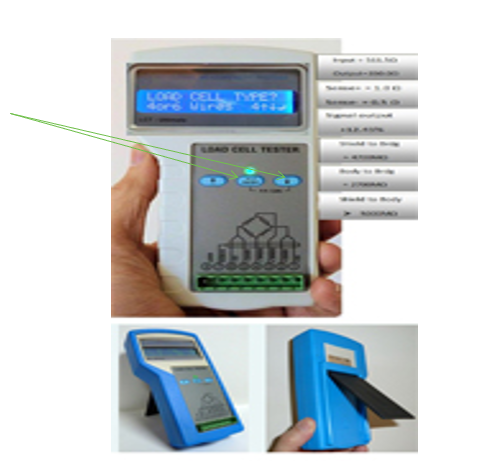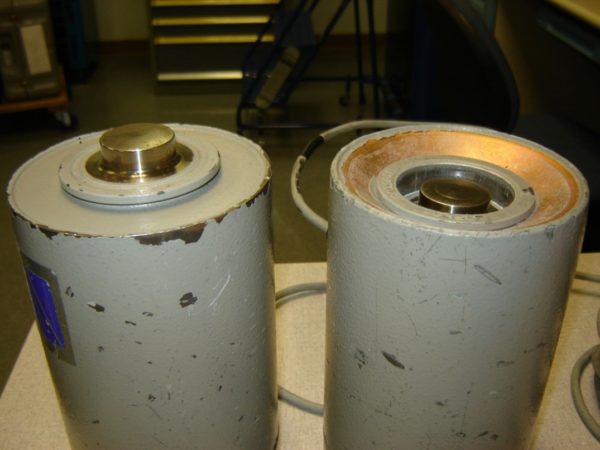What is a Load Cell Tester (LCT)
Morehouse LCT 100 Load Cell Tester is a stand-alone hand-held device that was specially designed for full troubleshooting of strain-gage-based load cells.
When load cells have problems, identifying the nature of the problem becomes an urgent matter. A technician's time is valuable. The Load Cell Tester will save time and money when problems do arise.
The Load Cell Tester will reduce the misidentification of equipment faults and their respective causes so that corrective actions can be more effectively implemented. Several labs using the Load Cell Tester have saved countless hours of unnecessary troubleshooting.
A Load Cell Tester will benefit anyone who needs to diagnose load cell issues. A Morehouse Load Cell Tester can check all common types of standard load cells that are available in the market (4 or 6 Wire Connections). The LCT will perform the following:
- Provides the user with all essential data needed about the tested load cell: Bridge resistance and integrity, physical distortion and can check insulation resistance
- Can be used to check multi-load-cell scale alignment
- Can check zero balance of the load cell (This is a leading indicator of overload if over 1 % of rated output)
- Continuous signal reading allows checking linearity and repeatability
- Very user-friendly, full test within seconds
Typical Tests needed to properly diagnose or check a load cell are:
- Bridge Resistance Test – Can be performed with an inexpensive multimeter. ($25)
- Load Cell Signal Output (Zero Balance) Typically requires a higher-end Multimeter ($ 1500 plus)
- Insulation to detect Moisture – Megger Tester to check 5000 Mega Ohms ($1000 plus)
- Linearity – Some meters can do this, recommend 5.5-digit DVM ($1500 plus)
Note: 1,2,4 can typically be done on 5.5-digit DVM. The load cell tester is one unit that can do all these tests and more in less than 5 minutes.
More information, specifications, and product data sheets can be found here.
How to Use a Morehouse Load Cell Tester (LCT)
A video is on YouTube @
Quick Simple Checks LCT Instructions below.

- Plugin the cable following the wiring instructions for the load cell you are testing
- Power on the unit by holding both buttons for 3 seconds.
- Select the appropriate wiring for the configuration 4 or 6-wire
- Input the full-scale output (If a Morehouse shear web cell is above 2000 lbf, the output should be 4 mV/V, If 2000 lbf or under 2 mV/V)
- Run the tests
This simple test will show Input and Output Resistance, the difference between sense and excitation leads, Signal Output (Zero Balance)
These are the most common tests to quickly check if the load cell has been damaged. Most load cells will show 350 OHM ± 3.5 OHMs for Input and Output Resistance. The Signal Output will be the Zero Balance Percentage and anything above 1 % is suspected of being overloaded.
Additional Notes:
Input or Output Resistance
- If the resistance is not in range, there may be a cable or connector problem. There may be internal damage to the bridge of the load cell.
- Check the manufacturer's specifications to know what the resistance should be. The tester should show a value within plus or minus 5 ohms of what the manufacturer states.
Sense is too High
- If the Sense is too high (6-wire cell), the sense lines may not be connected (4-wire cell). Or, if one of the sense readings is high, then there is probably a cable error.
Signal Output is Too High
- Typically, if the signal output is over 1 % - 5 %, the load cell has either been overloaded or there is corrosion somewhere in the cable or cell.
Shield to Bridge, Body to Bridge, and Shield to Body
- The load cell insulation resistance specifications for load cell body to bridge is >5000 MegOhms at 23 °C. (on the tester Shield to Body > 5000, 5000 MegOhms)
- We typically do not recommend that the shield is attached to the load cell body to prevent ground loops so the shield to body or bridge will generally meet the same specification. This will most likely be > 5000MegaOhm and the meter will flash red if it is not okay.
Results of Overloading

- Mechanical damage has been done that is not repairable.
- Permanent deformation within the flexural element and gauges, which destroys the carefully balanced processing.
- Residual stresses and strains are introduced into the structure.
- The past mechanical history of the flexure, gauge alloy, backing, and adhesive is altered.
- The load cell symmetry is affected as well as the compression and/or tension output.
- Strain Gauge characteristics are modified, such as Resistance and Gauge factor, which will modify the temperature coefficients.
- While it is possible to electrically re-zero a load cell following overload, it is not recommended because this does nothing to restore the affected performance parameters or the degradation to structural integrity.
Morehouse can diagnose problematic load cells. We use the load cell tester to perform these checks. Some damage is repairable, and overloads are not. An overloaded load cell warrants a replacement as it is more expensive to try and fix than replace.
How to use a Load Cell Tester Quickly Diagnose 5 Common Load Cell Issues - Conclusion
A load cell tester is a great quick load cell diagnostic tool that can quickly save hours of time and headaches.
I take great pride in our knowledgeable team at Morehouse, who continue to work with everyone, clarify complex topics, and provide tools such as free guidance documents, excel sheets, and products such as the Morehouse load cell tester to help you make better force measurements.
At Morehouse, we educate our customers and provide solutions to quickly diagnose load cell issues. We have a guidance document on how to troubleshoot a load cell that can be found here.
We have been in business for over a century and focus on being the most recognized name in the force business. That vision comes from educating our customers on what matters most, having the proper discussions relating to force calibration concepts, so everyone uses the proper methods and math.
If you enjoyed this article, check out our LinkedIn and YouTube channel for more helpful posts and videos.
Everything we do, we believe in changing how people think about force and torque calibration. We challenge the "just calibrate it" mentality by educating our customers on what matters, what causes significant errors, and how to focus on reducing them.
In addition, Morehouse makes simple-to-use calibration products. We build excellent force equipment that is plumb, level, square, and rigid. Morehouse provides unparalleled calibration service with less than two-week lead times.
Contact us at 717-843-0081 to speak to a live person or email info@mhforce.com for more information.
#Load Cell Tester


